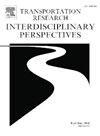Assessing the risk of traffic accidents in lisbon using a gradient boosting algorithm with a hybrid classification/regression approach
IF 3.8
Q2 TRANSPORTATION
Transportation Research Interdisciplinary Perspectives
Pub Date : 2025-06-19
DOI:10.1016/j.trip.2025.101495
引用次数: 0
Abstract
Traffic accidents significantly impact public health and economy through injuries, fatalities, and property damage. Effective emergency response planning requires sophisticated risk prediction tools with precise spatial and temporal resolution. While previous studies have assessed accident risk, they typically employed coarse spatial grids that lack the street-level detail crucial for emergency operations. This research presents a novel two-stage gradient-boosting predictive model, using tree-based learning algorithms to analyze traffic accidents requiring firefighter intervention in Lisbon, Portugal. To address the inherently unbalanced nature of accident data, we developed a sequential approach: first, a classification model identifies locations with non-zero accident probability; second, a regression model quantifies accident probabilities at street level across different time periods. The resulting risk simulator enables emergency planners to recalculate accident probabilities when street characteristics or weather conditions change, providing actionable insights for resource allocation and response planning. This research contributes both methodologically, through its innovative handling of spatially imbalanced data, and practically, by delivering an operational tool that supports evidence-based emergency service management. Validation results demonstrate the model’s effectiveness in predicting high-risk locations and times, allowing for proactive deployment of emergency resources.
基于混合分类/回归方法的梯度提升算法评估里斯本交通事故风险
交通事故通过伤害、死亡和财产损失对公众健康和经济产生重大影响。有效的应急规划需要具有精确空间和时间分辨率的复杂风险预测工具。虽然以前的研究已经评估了事故风险,但它们通常采用粗糙的空间网格,缺乏对紧急行动至关重要的街道细节。本研究提出了一种新的两阶段梯度增强预测模型,使用基于树的学习算法来分析葡萄牙里斯本需要消防员干预的交通事故。为了解决事故数据固有的不平衡性质,我们开发了一种顺序方法:首先,分类模型识别非零事故概率的位置;其次,回归模型量化了不同时期街道层面的事故概率。由此产生的风险模拟器使应急计划人员能够在街道特征或天气条件发生变化时重新计算事故概率,为资源分配和响应计划提供可操作的见解。该研究通过对空间不平衡数据的创新处理,在方法上做出了贡献,在实践上提供了一种支持循证应急服务管理的操作工具。验证结果表明,该模型在预测高风险地点和时间方面是有效的,可以主动部署应急资源。
本文章由计算机程序翻译,如有差异,请以英文原文为准。
求助全文
约1分钟内获得全文
求助全文
来源期刊

Transportation Research Interdisciplinary Perspectives
Engineering-Automotive Engineering
CiteScore
12.90
自引率
0.00%
发文量
185
审稿时长
22 weeks
 求助内容:
求助内容: 应助结果提醒方式:
应助结果提醒方式:


